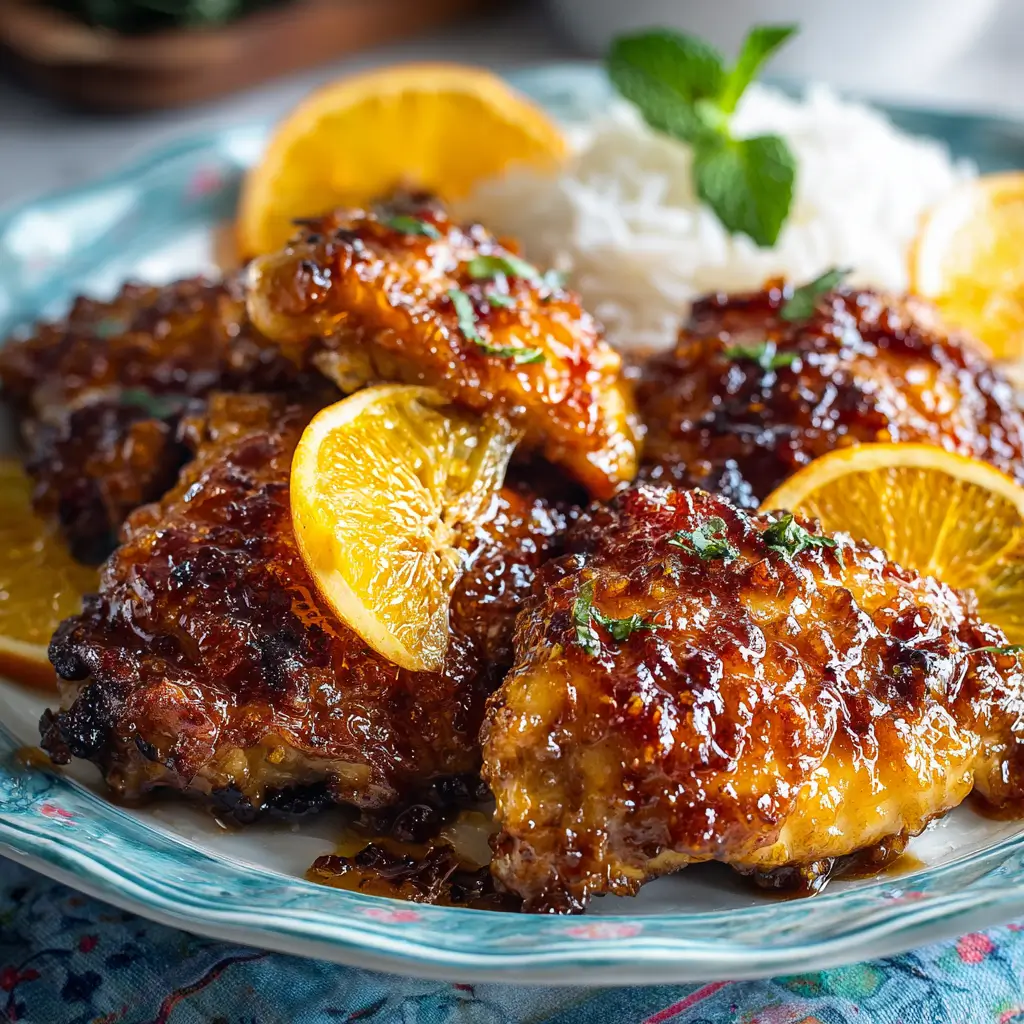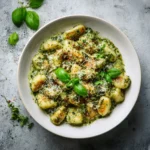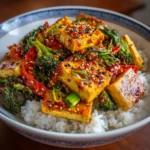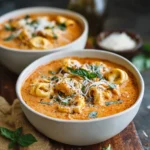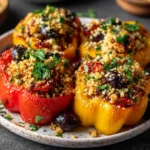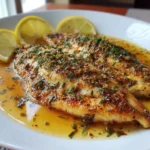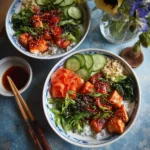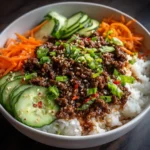Introduction
Sticky Orange Glazed Chicken is a vibrant, flavor-packed dish that combines the perfect balance of sweet, tangy, and savory elements to create a meal that’s both comforting and exciting. This recipe has gained popularity in recent years due to its simplicity, bold taste, and versatility—making it ideal for weeknight dinners, weekend family meals, or even elegant dinner parties. The glossy, caramelized glaze clings beautifully to tender pieces of chicken, delivering a burst of citrusy freshness with every bite. Whether you’re a seasoned cook or just beginning your culinary journey, this Sticky Orange Glazed Chicken will become a staple in your recipe rotation thanks to its easy preparation and universally loved flavors.
The History
The origins of Sticky Orange Glazed Chicken can be traced back to a fusion of Asian and Western culinary traditions. While dishes featuring citrus-glazed meats have long existed in Chinese cuisine—such as the classic “Orange Chicken” popularized by American-Chinese restaurants—this version takes inspiration from both traditional techniques and modern flavor preferences. In China, citrus fruits like bitter oranges and tangerines have been used in cooking for centuries, particularly in southern regions like Hunan and Sichuan, where bold, spicy, and sour flavors dominate. However, the sweeter, stickier version we know today evolved primarily in North America during the late 20th century, as chefs adapted authentic recipes to suit local palates.
Over time, home cooks began experimenting with more natural ingredients, reducing excessive sugar and MSG, and incorporating fresh orange juice and zest for a brighter profile. Today’s Sticky Orange Glazed Chicken reflects this evolution—offering a refined balance between sweetness and acidity while maintaining that irresistible sticky texture achieved through simmering the sauce until thick and luscious. It stands as a testament to how global cuisines influence one another, creating new classics that honor tradition while embracing innovation.
Ingredients Breakdown
- Chicken: Boneless, skinless chicken thighs or breasts are ideal. Thighs tend to stay juicier during cooking, but breasts work well if monitored closely to avoid drying out.
- Fresh Oranges: Two large oranges are used—one for juice and one for zest. Freshly squeezed orange juice provides a bright, clean flavor compared to bottled versions.
- Soy Sauce: Adds umami depth and saltiness. Use low-sodium soy sauce to control salt levels, especially when reducing the glaze.
- Honey: Acts as a natural sweetener and contributes to the sticky consistency of the glaze. Can be substituted with maple syrup or brown sugar.
- Rice Vinegar: Brings a mild tanginess that balances the sweetness and enhances overall complexity.
- Garlic: Minced fresh garlic infuses the dish with aromatic warmth and depth.
- Ginger: Freshly grated ginger adds a subtle heat and zesty note that complements the citrus beautifully.
- Sesame Oil: A small amount imparts a nutty aroma and richness, elevating the overall fragrance of the dish.
- Green Onions: Used as garnish for freshness and color contrast.
- Cornstarch (optional): Helps thicken the glaze for an extra sticky finish, especially useful if serving over rice or noodles.
- Red Pepper Flakes (optional): For those who enjoy a touch of heat, these add a gentle spiciness without overpowering the citrus notes.
- Olive Oil or Neutral Oil: For searing the chicken—avocado or grapeseed oil also work well due to their high smoke points.
Step-by-Step Recipe
- Prepare the Chicken: Cut 1.5 pounds of boneless, skinless chicken into 1-inch cubes. Pat them dry with paper towels to ensure proper browning. Season lightly with salt and pepper.
- Sear the Chicken: Heat 1 tablespoon of olive oil in a large skillet or wok over medium-high heat. Add the chicken in a single layer (work in batches if needed) and cook for about 5–6 minutes, turning occasionally, until golden brown on all sides. Remove and set aside.
- Make the Glaze Base: In the same pan, reduce heat to medium. Add 1 teaspoon sesame oil, followed by 3 cloves minced garlic and 1 tablespoon freshly grated ginger. Sauté for 30 seconds until fragrant, being careful not to burn.
- Build the Sauce: Pour in ¾ cup freshly squeezed orange juice (from about 1 large orange), ¼ cup low-sodium soy sauce, ¼ cup honey, and 1 tablespoon rice vinegar. Stir well to combine. If using red pepper flakes, add ½ teaspoon now.
- Simmer and Thicken: Bring the mixture to a gentle boil, then reduce to a simmer. In a small bowl, mix 1 tablespoon cornstarch with 2 tablespoons cold water to make a slurry. Slowly whisk it into the sauce. Cook for 3–5 minutes, stirring frequently, until the sauce thickens and turns glossy.
- Return Chicken to Pan: Add the seared chicken back into the skillet, stirring to coat every piece evenly with the glaze. Continue cooking for another 4–5 minutes, allowing the chicken to absorb the flavors and heat through completely.
- Finish with Zest and Garnish: Turn off the heat. Stir in the zest of one orange for a burst of aromatic citrus. Taste and adjust seasoning—add more honey for sweetness, soy sauce for saltiness, or a splash of vinegar for acidity.
- Serve: Transfer to a serving platter. Garnish generously with sliced green onions and optional toasted sesame seeds. Serve immediately alongside steamed jasmine rice, quinoa, or stir-fried vegetables.
Tips
- Use Fresh Citrus: Bottled orange juice often contains preservatives and added sugars that can alter the flavor. Always opt for fresh-squeezed juice and zest for the best results.
- Don’t Overcook the Chicken: Since the chicken is cooked twice (once before and once after simmering), be cautious not to leave it too long in the sauce, which can lead to dryness—especially with breast meat.
- Brown in Batches: Avoid overcrowding the pan when searing; this ensures proper caramelization rather than steaming the chicken.
- Adjust Sweetness: Depending on the tartness of your oranges, you may need to tweak the amount of honey. Start with less and add more to taste.
- Let the Glaze Reduce Properly: Allow enough time for the sauce to thicken so it coats the chicken luxuriously without being watery.
- Rest Before Serving: Let the dish sit for 2–3 minutes after cooking. This allows the glaze to cling better and the flavors to settle.
- Double the Sauce? If you love extra glaze for drizzling over rice, consider increasing the sauce ingredients by 50%.
- Prep Ahead: You can marinate the chicken in a bit of soy sauce, garlic, and ginger for up to 2 hours beforehand to deepen the flavor profile.
Variations and Customizations
- Spicy Orange Glazed Chicken: Add 1 finely chopped red chili or increase red pepper flakes to 1 teaspoon. Alternatively, stir in 1–2 teaspoons of sriracha or chili garlic sauce.
- Pineapple Twist: Replace half the orange juice with pineapple juice for a tropical flair. Add diced pineapple during the final simmer.
- Teriyaki-Inspired Version: Swap half the orange juice for mirin and add a pinch of ground star anise for a richer, more complex glaze.
- Gluten-Free Option: Use tamari or coconut aminos instead of soy sauce to make this dish gluten-free.
- Vegan Alternative: Substitute chicken with tofu or tempeh. Press and cube firm tofu, then pan-fry until crispy before adding to the glaze.
- Honey-Free Version: Replace honey with agave nectar, maple syrup, or monk fruit syrup for a vegan or lower-glycemic option.
- Slow Cooker Method: Brown chicken first, then transfer to a slow cooker with all sauce ingredients. Cook on low for 4–5 hours. Thicken sauce on stove afterward.
- Grilled Sticky Orange Chicken: Marinate chicken pieces, then grill over indirect heat. Brush with warmed glaze during the last few minutes of grilling for smoky, sticky perfection.
- Meal Prep Friendly: This dish reheats exceptionally well. Store portions with rice in containers for up to 4 days in the fridge or freeze for up to 3 months.
- Kids’ Version: Reduce or omit spices and add a little extra honey to appeal to younger taste buds.
Health Considerations and Nutritional Value
Sticky Orange Glazed Chicken offers a balanced nutritional profile when prepared with mindful ingredient choices. A typical 4-ounce serving (without rice) contains approximately:
- Calories: 280–320 kcal
- Protein: 27–30g (excellent source of lean protein)
- Fat: 8–10g (mostly from healthy oils and chicken)
- Carbohydrates: 25–30g (primarily from natural sugars in honey and orange juice)
- Sodium: 600–800mg (can be reduced by using low-sodium soy sauce)
- Vitamin C: High—thanks to fresh oranges, supporting immune function
- Zinc & Iron: Present in moderate amounts from chicken, aiding metabolism and oxygen transport
To make this dish healthier:
- Reduce honey or use a natural zero-calorie sweetener.
- Increase vegetable content by serving over cauliflower rice or a bed of sautéed broccoli, bell peppers, and snap peas.
- Limit cornstark usage or skip it entirely for a lighter glaze.
- Choose chicken thighs with some fat removed or use breast meat for lower fat content.
- Add fiber-rich sides like roasted Brussels sprouts or a mixed greens salad with mandarin slices.
This dish is naturally free from dairy and nuts, making it suitable for many dietary needs. However, always check labels on soy sauce if avoiding gluten or specific allergens.
Ingredients
- 1.5 lbs (680g) boneless, skinless chicken thighs or breasts, cubed
- 2 large oranges (1 juiced, 1 zested)
- ¼ cup honey (or maple syrup)
- ¼ cup low-sodium soy sauce (or tamari for gluten-free)
- 1 tbsp rice vinegar
- 3 cloves garlic, minced
- 1 tbsp fresh ginger, grated
- 1 tbsp olive oil or avocado oil
- 1 tsp sesame oil
- ½ tsp red pepper flakes (optional)
- 1 tbsp cornstarch + 2 tbsp water (for slurry)
- 3 green onions, sliced (for garnish)
- 1 tsp toasted sesame seeds (optional garnish)
Directions
- Pat chicken dry and season lightly with salt and pepper.
- Heat olive oil in a large skillet over medium-high heat. Sear chicken in batches until golden brown on all sides. Remove and set aside.
- In the same pan, add sesame oil, garlic, and ginger. Sauté for 30 seconds until fragrant.
- Pour in orange juice, soy sauce, honey, rice vinegar, and red pepper flakes. Stir well.
- Bring to a boil, then reduce to a simmer. Whisk in cornstarch slurry and cook for 3–5 minutes until sauce thickens.
- Return chicken to the pan and stir to coat. Simmer for 4–5 minutes until chicken is fully cooked and glazed.
- Turn off heat. Stir in orange zest and green onions.
- Garnish with additional green onions and sesame seeds. Serve hot with rice or vegetables.
FAQ
Can I use frozen orange juice concentrate?
It’s not recommended, as it often contains added sugars and lacks the fresh brightness of real oranges. If necessary, dilute it according to package instructions and taste carefully before adjusting sweetness.
How do I store leftovers?
Store in an airtight container in the refrigerator for up to 4 days. Reheat gently in a skillet or microwave, adding a splash of water or broth to loosen the glaze if needed.
Can I freeze Sticky Orange Glazed Chicken?
Yes! Freeze in portioned containers for up to 3 months. Thaw overnight in the fridge and reheat slowly on the stove.
Why is my glaze too thin?
The cornstarch slurry might not have been cooked long enough. Simmer the sauce for a few more minutes until it reaches a syrupy consistency. Make sure to stir constantly to prevent burning.
What can I serve with this dish?
Excellent pairings include steamed jasmine rice, coconut rice, quinoa, lo mein noodles, or roasted vegetables like asparagus, carrots, or bok choy.
Can I make this in an Instant Pot?
Absolutely. Use the sauté function to brown the chicken, then add all sauce ingredients. Pressure cook for 8 minutes with a quick release. Thicken the sauce using the sauté mode afterward.
Is this recipe kid-friendly?
Yes! Most children enjoy the sweet-tangy flavor. Omit red pepper flakes and consider cutting the chicken into smaller, bite-sized pieces for easier eating.
Can I use chicken wings instead?
Definitely. Bake or air-fry chicken wings until crispy, then toss them in the warm glaze for a sticky, finger-food version perfect for parties.
Summary
Sticky Orange Glazed Chicken is a mouthwatering fusion dish that blends sweet citrus, savory soy, and aromatic spices into a tender, glossy masterpiece. Easy to prepare and endlessly customizable, it’s sure to become a favorite in your kitchen.
